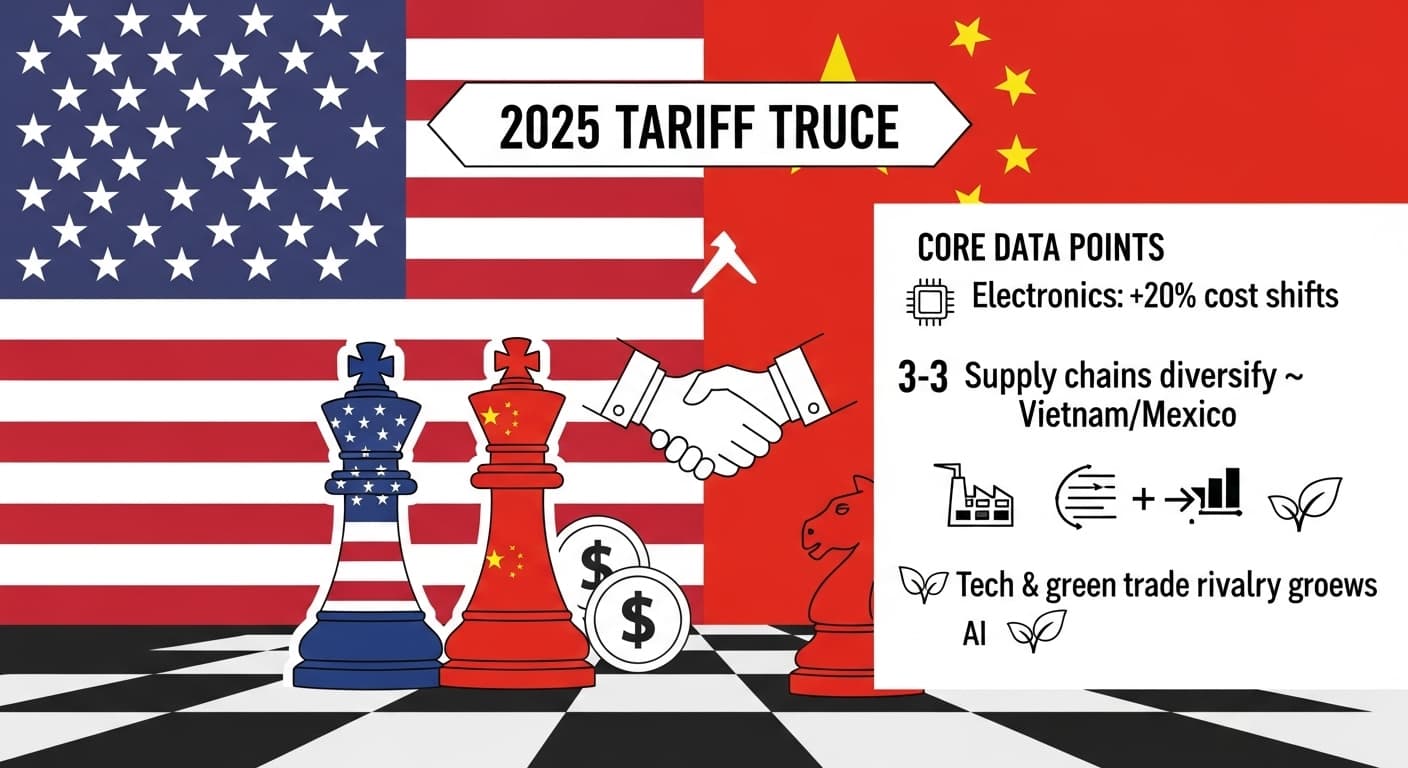
Executive Summary
The October 2025 US-China trade negotiations in Kuala Lumpur produced a preliminary framework agreement addressing key points of tension between the world’s two largest economies. Discussions held on the sidelines of the ASEAN Summit yielded basic consensus on tariff escalation, rare earth mineral export controls, agricultural trade, and technology sector concerns. While specific details and ultimate implementation remain subject to high-level review and finalization, the framework provides important signals about potential directions for bilateral trade relations and their implications for global supply chains.
US-China Trade Framework: Understanding the Kuala Lumpur Negotiations and Supply Chain Implications
(美中贸易框架:了解吉隆坡谈判与供应链影响)
1 · Negotiation Context and Background
The October 2025 Kuala Lumpur discussions represent the latest chapter in complex, evolving US-China trade relations that have undergone substantial transformation since initial trade tensions emerged.
Historical Trade Tensions
Evolution of Trade Relations: US-China trade relations have experienced significant strain over recent years through multiple phases of tariff implementation, negotiation periods, enforcement challenges, and periodic escalation and de-escalation cycles.
Current Tariff Structure: As of October 2025, US tariffs on Chinese imports reflect multiple layers of actions including Section 301 tariffs targeting various product categories, additional duties under IEEPA authority, and various sector-specific measures. These accumulated tariffs significantly affect import costs and supply chain economics for many product categories.
Chinese Countermeasures: China has implemented its own retaliatory measures including tariffs on US exports, export control restrictions on certain materials and technologies, and regulatory actions affecting US companies operating in China.
Negotiation Framework Development
ASEAN Summit Context: The Kuala Lumpur discussions occurred on the sidelines of the ASEAN Summit, providing neutral venue and multilateral context for bilateral negotiations. Regional setting emphasized broader Asian economic integration concerns and interests.
Participant Representation: US Treasury Secretary Scott Bessent led American negotiating team, while Chinese counterparts included senior officials with authority to discuss major trade and economic issues. Two-day intensive discussions addressed multiple dimensions of bilateral trade relationship.
Preliminary Nature: The resulting framework represents preliminary understanding requiring high-level review and approval. Agreements reached at technical level must be reviewed by Presidents Trump and Xi before formal implementation, introducing uncertainty about ultimate outcomes.
2 · Key Framework Components
The preliminary framework addresses several critical issues that have characterized US-China trade tensions and created supply chain uncertainties.
Tariff Escalation Pause
Threatened Measures: Prior to negotiations, discussions had circulated regarding potential significant tariff increases on Chinese imports, with some proposals suggesting rates as high as 100% on certain goods. These potential escalations created substantial uncertainty for businesses managing China-sourced supply chains.
Framework Agreement: According to available information, the preliminary framework includes understanding to pause implementation of additional substantial tariff increases, providing breathing room for continued negotiations and supply chain planning.
Mutual Considerations: The tariff pause appears linked to Chinese actions on other issues, reflecting negotiated compromise rather than unilateral concessions by either party.
Rare Earth Mineral Export Controls
Strategic Material Concerns: Rare earth minerals represent critical inputs for various high-technology applications including electric vehicle batteries, renewable energy systems, consumer electronics, and defense applications. China dominates global rare earth production and processing, creating strategic vulnerabilities for countries dependent on these materials.
Chinese Control Measures: China has implemented or threatened export restrictions on rare earth minerals as potential countermeasure in trade disputes. Such restrictions could significantly disrupt supply chains for technology and manufacturing sectors.
Framework Understanding: Reports suggest the framework includes Chinese agreement to delay implementation of stricter rare earth export controls for specified period, potentially one year. This delay provides time for affected industries to develop alternative sourcing or adjust supply chains.
Strategic Implications: While temporary delay provides near-term relief, longer-term resolution requires either sustained Chinese cooperation, development of alternative supply sources, or fundamental reconsideration of rare earth dependencies in critical supply chains.
Agricultural Trade Commitments
Soybean Purchases: The framework reportedly includes Chinese commitments to increase purchases of US soybeans and potentially other agricultural products. Agricultural trade has represented persistent negotiation topic in US-China trade discussions.
Trade Balance Considerations: Increased Chinese purchases of US agricultural products address American concerns about trade imbalances while providing Chinese access to needed food and feed supplies.
Implementation Questions: While purchase commitments provide positive signals, actual implementation and sustained follow-through require monitoring. Previous trade agreements have included agricultural purchase commitments with varying degrees of fulfillment.
Technology and Security Issues
TikTok Operations: According to reports, negotiations addressed ongoing concerns about TikTok operations in the United States, with some form of agreement reached addressing data security and operational concerns.
Broader Technology Concerns: Beyond specific TikTok issues, broader technology transfer concerns, export controls, and technology sector competition remain significant elements of US-China trade relationship requiring ongoing attention.
Fentanyl Cooperation: Discussions reportedly touched on cooperation regarding fentanyl precursor chemicals and enforcement, addressing significant US concern about drug trafficking and Chinese chemical exports.
3 · Supply Chain Implications
The preliminary framework creates various implications for supply chains currently navigating US-China trade tensions.
Import Cost Predictability
Tariff Stability: The pause on additional substantial tariff increases provides greater cost predictability for businesses sourcing from China, enabling more confident planning and reducing need for rushed supply chain restructuring.
Planning Horizon: While not eliminating all uncertainty, the framework extends planning horizon for China-sourced supply chains, allowing more deliberate rather than crisis-driven adjustments.
Competitive Dynamics: Tariff stability affects competitive dynamics among suppliers. Companies that maintained China sourcing despite tensions may benefit from avoiding further cost disadvantages, while those that already diversified face questions about whether premature moves created unnecessary costs.
Rare Earth Supply Considerations
Technology Sector Impact: Delay in rare earth export control implementation provides relief for technology manufacturers, electric vehicle producers, and renewable energy equipment suppliers dependent on these materials.
Alternative Source Development: The delay period provides opportunity to develop alternative sourcing including Australian rare earth projects, processing capacity outside China, and recycling capabilities recovering rare earths from end-of-life products.
Strategic Planning: Rather than viewing delay as permanent solution, companies should use the breathing room for strategic rare earth supply planning addressing long-term dependencies.
Agricultural Supply Chains
Grain Export Flows: Increased Chinese soybean purchases affect US agricultural exports, grain logistics, and related supply chains including transportation from farm regions to export terminals and vessel scheduling and freight rates.
Price Effects: Substantial purchase commitments can affect agricultural commodity prices, with implications for producers, processors, and ultimately consumers of products using these commodities as inputs.
4 · Strategic Considerations for Businesses
Organizations managing supply chains affected by US-China trade relations should consider various strategic responses to the preliminary framework.
Near-Term Tactical Adjustments
Contract and Pricing Reviews: The framework creates opportunity to review supplier contracts, pricing arrangements, and related agreements considering greater stability in tariff environment. Some businesses may choose to lock in pricing based on current tariff levels rather than building in additional contingency.
Inventory Management: Greater cost predictability may enable inventory optimization, reducing safety stock levels maintained as buffer against tariff uncertainty while maintaining service levels.
Transportation Planning: Supply chain stability supports more confident transportation planning and capacity commitments, potentially enabling better rates through volume commitments rather than spot market reliance.
Medium-Term Strategic Planning
Diversification Reassessment: The framework creates opportunity to reassess supply chain diversification strategies, evaluating whether alternative sourcing developed during tension periods remains optimal or whether rebalancing toward China makes sense for certain products.
China Plus One Evolution: Many companies adopted “China plus one” strategies developing alternative supply bases while maintaining Chinese sourcing. The framework affects how these dual-source strategies should evolve.
Investment Decisions: Facility location decisions, supplier development investments, and related long-term commitments benefit from framework’s greater stability, though prudent planning still maintains flexibility given implementation uncertainties.
Risk Management Approaches
Scenario Planning: While framework provides positive signals, prudent planning develops scenarios for various outcomes including successful implementation and sustained improvement, stalemate with current framework elements but no further progress, or renewed escalation if high-level review rejects framework.
Monitoring Mechanisms: Establishing systematic monitoring of trade policy developments, implementation of framework elements, and indicators suggesting potential changes enables responsive rather than reactive management.
5 · Implementation Uncertainties and Considerations
While the preliminary framework provides important signals, various uncertainties affect ultimate outcomes and implications.
High-Level Review Process
Presidential Approval: The framework requires review and approval by Presidents Trump and Xi before formal implementation. This high-level review introduces uncertainty, as leaders might modify, reject, or approve framework elements based on broader political and strategic considerations.
Summit Timing: Reports suggest review occurring at upcoming summit meeting, though specific timing and format may vary. Delays or changes to summit plans could affect implementation timeline.
Domestic Political Considerations: Both US and Chinese leaders face domestic political considerations affecting their willingness to embrace framework elements. US concerns about appearing soft on China and Chinese sensitivities about sovereignty and national interests both affect negotiating positions.
Implementation Details
Specific Mechanisms: The preliminary framework represents high-level agreement on principles rather than detailed implementation mechanisms. Converting principles into specific operational procedures, monitoring approaches, and enforcement mechanisms requires substantial additional work.
Verification and Compliance: Ensuring compliance with framework elements—particularly regarding agricultural purchases, rare earth export policies, and technology sector arrangements—requires verification mechanisms and potential dispute resolution procedures.
Timeline Considerations: Different framework elements may have different implementation timelines. Some actions may occur quickly while others require longer development periods.
External Factors
Third-Party Impacts: Framework elements may affect third parties including other countries, international organizations, and private sector entities not directly represented in negotiations. These impacts may create additional complexities or resistance.
Broader Geopolitical Context: US-China trade relations exist within broader geopolitical competition and strategic tensions. Developments in security, technology, regional influence, and other domains may affect willingness to implement and sustain trade framework elements.
6 · Broader Market and Economic Implications
The preliminary framework creates implications extending beyond direct participants to broader markets and economic systems.
Financial Market Responses
Equity Market Reactions: Initial market responses to framework news have generally been positive, with equity markets viewing reduced trade tension as supporting economic growth and corporate profitability prospects.
Sector-Specific Impacts: Different sectors experience varied impacts based on their exposure to US-China trade issues. Technology companies, agricultural producers, and manufacturers with China exposure show particular sensitivity to trade policy developments.
Emerging Market Effects: Reduced US-China tension generally supports emerging market assets by reducing global trade policy uncertainty and supporting economic growth prospects in developing economies integrated in global supply chains.
Competitive Dynamics
China Versus Alternative Sourcing: Framework elements affect competitive positioning of Chinese suppliers relative to alternative sources in Vietnam, India, Mexico, and elsewhere. Greater China sourcing stability may slow diversification trends benefiting alternative locations.
Regional Trade Integration: US-China framework elements affect regional trade dynamics including ASEAN integration, Indo-Pacific economic frameworks, and other regional arrangements. Countries and regions position themselves relative to evolving US-China relationship.
7 · Long-Term Outlook and Strategic Positioning
Looking beyond immediate framework implementation, longer-term trends and strategic considerations affect how organizations should position themselves.
Structural Trade Relationship Evolution
Decoupling Versus Integration: The framework represents step toward maintaining economic integration rather than complete decoupling, though targeted restrictions on sensitive technologies and strategic goods likely persist.
Managed Competition: Emerging framework suggests shift toward managed competition where US-China trade continues with guardrails addressing security concerns rather than complete economic separation.
Technology Competition: Even with improved trade relations, competition in advanced technologies continues with implications for investment, innovation, and supply chain strategies in high-tech sectors.
Supply Chain Resilience Building
Permanent Diversification: Regardless of framework success, many companies view supply chain diversification as permanent strategic priority rather than temporary response to trade tensions. Multiple sourcing reduces vulnerability to various disruption types.
Nearshoring Momentum: Trends toward nearshoring and friendshoring continue driven by factors beyond US-China trade including pandemic lessons, climate concerns, and labor considerations.
Technology Enablers: Digital supply chain technologies, AI-driven optimization, and advanced analytics enable more sophisticated approaches to managing complex, diversified supply networks balancing cost, risk, and service.
8 · Conclusion: Navigating Evolving Trade Relations
Framework Significance
Positive Development: The preliminary Kuala Lumpur framework represents positive development in US-China trade relations, creating potential for reduced tensions, greater predictability, and improved supply chain stability. The framework addresses several key irritants in bilateral relationship.
Cautious Optimism: While framework provides encouraging signals, implementation uncertainties, political considerations, and broader geopolitical context warrant cautious rather than unreserved optimism about outcomes.
Ongoing Evolution: Trade relations between major economies evolve continuously based on changing economic conditions, political leadership, strategic considerations, and international developments. The framework represents one step in ongoing evolution rather than final resolution.
Strategic Positioning Principles
Balanced Approaches: Effective supply chain strategies balance multiple considerations including cost optimization, risk management, service requirements, and flexibility for adaptation. Over-optimization for single scenario creates vulnerability to changes.
Informed Monitoring: Systematic monitoring of trade policy developments, framework implementation progress, and broader economic and political trends enables responsive strategy adjustment rather than crisis reaction.
Scenario Flexibility: Maintaining flexibility to adapt to various potential scenarios—from sustained improvement to renewed tension—provides resilience regardless of specific outcomes.
Moving Forward
Organizations managing supply chains affected by US-China trade should:
- Monitor framework implementation developments closely
- Reassess supply chain strategies considering greater near-term stability
- Maintain strategic flexibility for various long-term scenarios
- Continue building resilient, diversified supply networks
- Engage with professional advisors on trade compliance and strategy
The Kuala Lumpur framework creates opportunity for improved trade relations and supply chain stability, though ultimate outcomes depend on implementation execution, political will, and broader contextual developments. Organizations that approach these developments strategically—with informed optimism balanced by prudent risk management—position themselves to benefit from improvements while maintaining resilience against potential setbacks.
This analysis reflects available information about preliminary framework discussions and their potential implications. Specific framework details, implementation approaches, and ultimate outcomes remain subject to high-level review, formal agreement processes, and practical implementation. Organizations affected by US-China trade issues should monitor official announcements and consult with trade policy specialists and legal advisors regarding specific implications for their circumstances.



